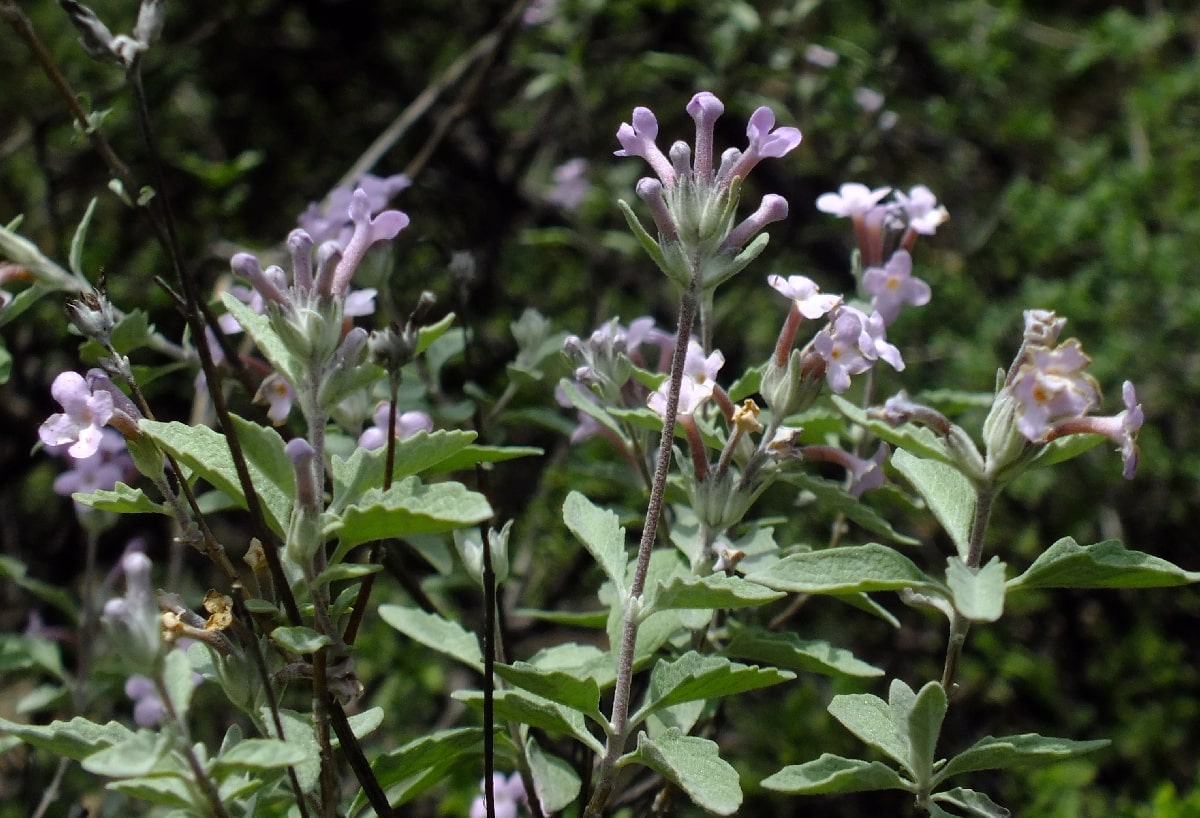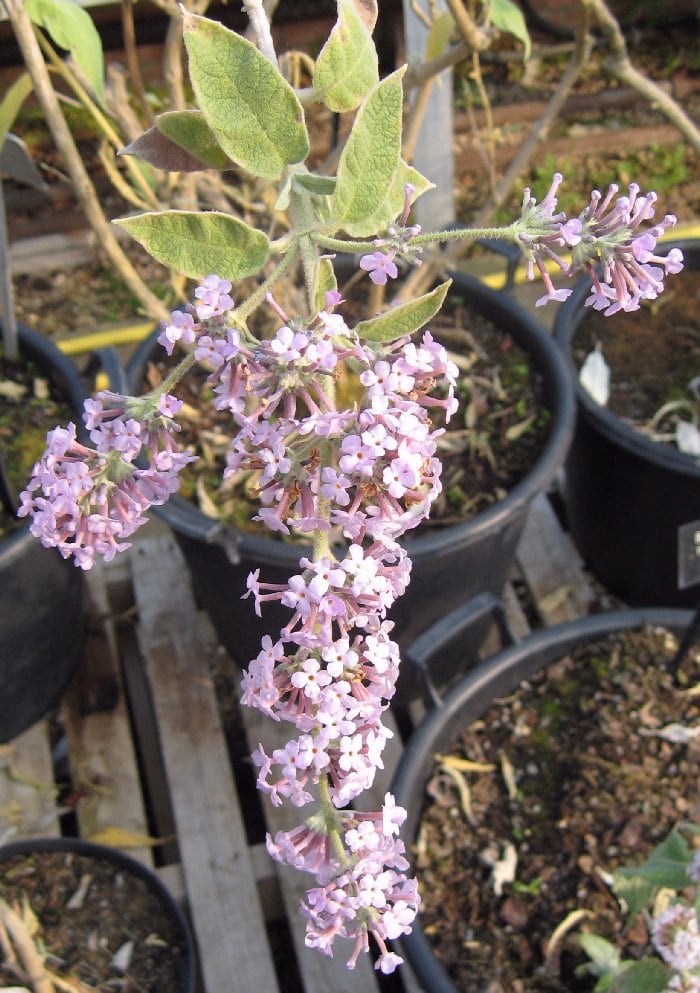
The Buddleja crispa Complex
Revised May 2022
In the monograph of Leeuwenberg (1979) and in many subsequent publications (e.g.: Li and Leeuwenberg 1996) several varieties previously classified as separate species were sunk under Buddleja crispa. This 'lumping' of so many diverse plants into a single species was debatable and not universally supported. However, the enthusiasm for seeking out, describing and naming plants in the late nineteenth and early twentieth century led to a multiple names being ascribed to a single species, or new species claimed based on the most minor of differences. The number of synonyms of B. crispa is therefore unusually large. However, several of those plants later included under B. crispa by Leeuwenberg can differ significantly from each other even though the core features suggest they belong to a single species. Several of these plants have continued to go by their former species names in horticulture. Strictly speaking they should be labelled as 'types' or 'cultivars', for example B. agathosma should be correctly known as B. crispa type agathosma, as they are not formal botanical 'forms', 'varieties' or 'subspecies'.
The ambiguous status of these types is reflected in the use of the term Buddleja crispa Complex to describe this group of Buddleja (Marquand 1930). The taxonomy of Leeuwenberg has not been revised since 1979, although more recent research has restored species status to at least one B. crispa type, B. caryopteridifolia (Zhang et al 2014). DNA technology is likely to elucidate and quantify the relatedness (or otherwise) of all the varieties and should replace traditional taxonomy based on observation with the more rigorous phylogeny of DNA sequence analysis. For convenience, they can be split into the summer flowering, represented by B. crispa (summer-flowering type) and B. caryopteridifolia, and the spring flowering B. crispa types: agathosma, farreri, sterniana and tibetica.
Their natural habitat of all the types is dry, rocky valleys in the Himalayas. These plants share silvery tomentose foliage and have very similar pale lilac to lilac-pink flowers; the justification for classifying all the types as a single species is the close similarity of the detailed flower morphology. They are all diploid with 38 chromosomes and are often self-compatible. B. crispa types hybridise readily with other Asian diploid species and with some African and South American species too. Hybrids of B.alternifolia and B. crispa are particularly numerous, including the naturally occuring hybrid B. x wardii.
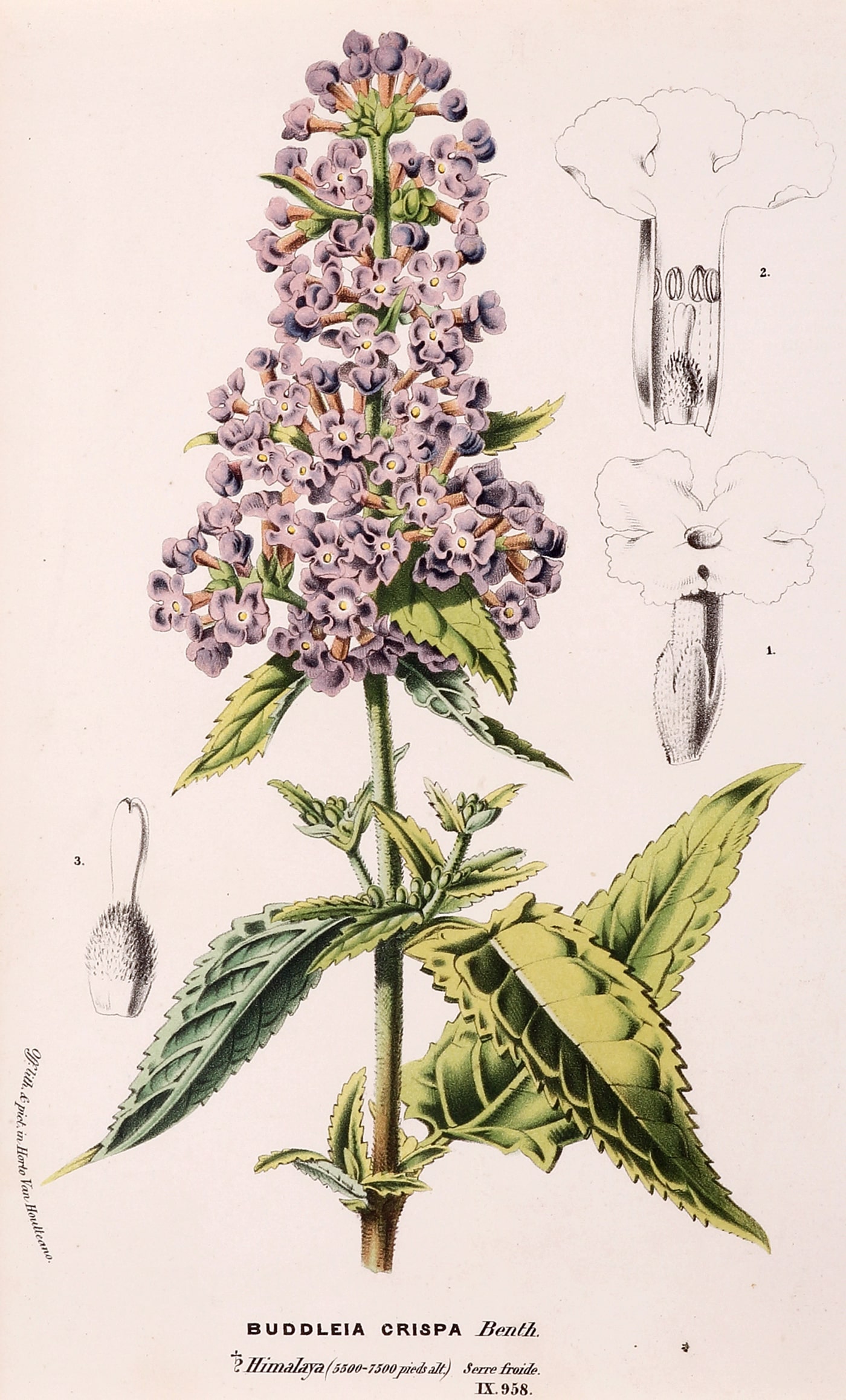
An antique lithograph of B. crispa by Louis van Houtte from Flore des Serres et des Jardins de l'Europe (1845-1888).
Open full-size image in a new window.
Summer Flowering
Buddleja crispa
Summer-Flowering Type
The commonly available form has very soft grey-green foliage, the leaves are triangular t almost heart-shaped with a very short petiole. The flowers are a contrasting lilac-pink and arranged in neat, small panicles. This is an attractive species Buddleja that can grow quite large and woody in the right conditions. Needing a warm south-facing wall or aspect to survive and very good drainage, it prefers dryish conditions even in summer, which enhances the silvery foliage. Like all B. crispa types, this one can't take any water-logging over winter. Growing in a large pot is an option, where it can be brought under cover and kept dry for winter, although it is still fully deciduous and prone to botrytis (grey mould) during the autumn. The flowers appear from June-July with a second flush in the autumn if it's dead-headed.
A plant that has been in cultivation for a long time, and possibly derives from a specimen once kept in the now-defunct Aldenham collection (Hertfordshire, UK), native origin unknown. So far there is only one selected cultivar from the USA called Moon Dance (syn.: Hulmoon), described as denser and more compact than the species type, it's probably no more than this plant given a cultivar name. Recently a variegated form has come to light from Stone House Cottage Garden in Worcestershire, which has foliage with irregular white leaf margins.
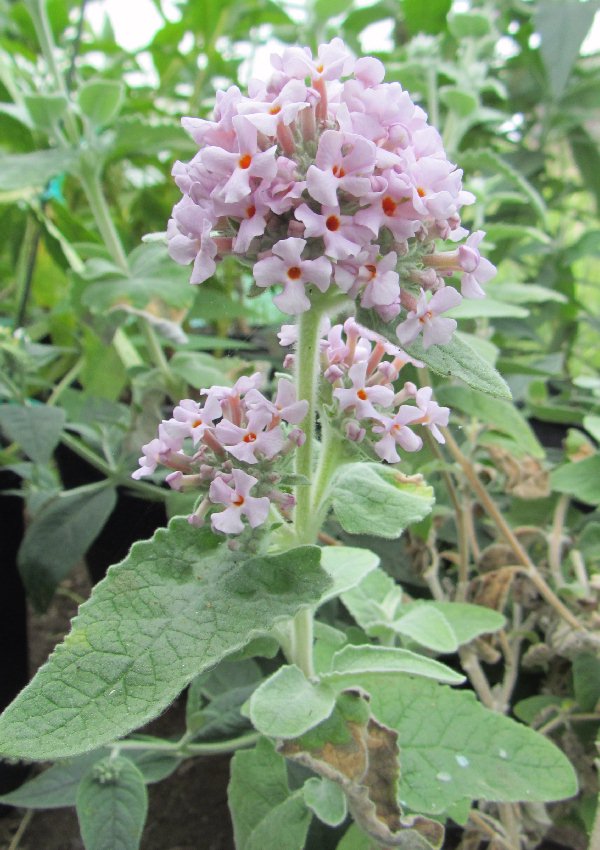
A typical B. crispa flower panicle.
Open full size image in a new window.
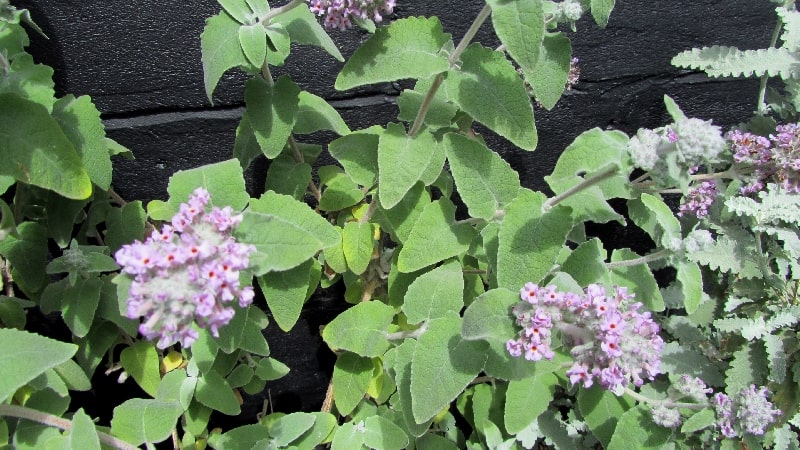
Typical B. crispa foliage.
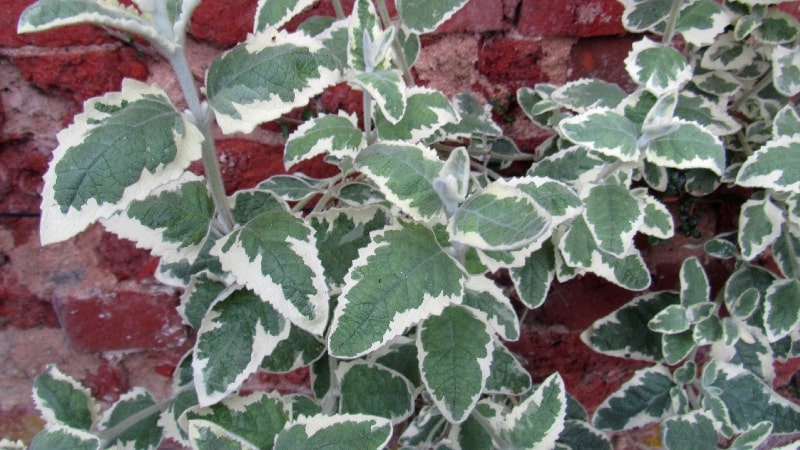
B. crispa 'Stone House Cottage', a variegated form.
Buddleja caryopteridifolia
This species was sunk by Leeuwenberg under B. crispa. Like the type above, the flowering period is from June until September. It shares a habitat with spring flowering B. crispa types in the hot-dry valleys of Sichuan and Yunnan. The foliage is small and silvery, resembling that of B. crispa type sterniana (see below), but the growth habit is more compact and globose. The inflorescences are very different, having just a few flowers in a upright thyrse.
This type has recently been re-confirmed as a species in its own right (Zhang et al 2014). Flower and leaf morphologies are significantly different from the B. crispa varieties and the compositions of the scents are chemically distinct. DNA analysis confirms that B. caryopteridifolia specimens from a seres of locations show a greater genetic similarity with each other than with any sympatric B. crispa specimens. The differing phenologies (flowering times) of the two species limits the possibility of genetic exchange between them and contributes to their separation.
The plant was introduced to the UK via the Royal Botanical Gardens Edinburgh, but may have become confused with type sterniana (Cotton 1947). The plant currently being sold in the UK as B. caryopteridifolia appears to be a hybrid of B.alternifolia, possibly B. x wardii or B. x pikei.
Buddleja caryopteridifolia in situ in Yunnan.
Open full size image in a new window.
Close-up of the flowers.
Photo courtesy of Prof. Weibang Sun,
Kunming Institute of Botany - Chinese Academy of Sciences.
Spring Flowering
Buddleja crispa
Type: agathosma
Buddleja agathosma, to give it its old name, is a large shrub and has the largest leaves of the Buddleja crispa types. The foliage haa toothed margins and is grey felted as with other B. crispa types; leaves can be up to 30cm in length on mature specimens. This size and relatively long petiole means they tend hang down. The foliage can be variable - the growing tips are almost white but the leaves gradually appear more green on the upper surfaceas the mature. On some stems the leaves have virtually no stipules, whereas elsewhere on the plant the leaves can be connate, the stipules entirely encircling the stem.
In the UK climate it is deciduous. The flower buds form in the previous autumn and are held dormant over the winter; they can be dessicated and lost in harsh winters. The flowers usually start to open before the foliage reappears in the spring, and the inflorescence can be very large, consisting of both a terminal and axillary panicles. The individual flower corolla has a greater diameter than the other varieties, up to 8mm, although the size and shape of the other flower parts is the same as the other types. The scent is particularly fine, for which this type is named.
It is usually grown as a wall shrub as it benefits from shelter out of the coldest winds, but is quite hardy once established unless in water-logged soil.
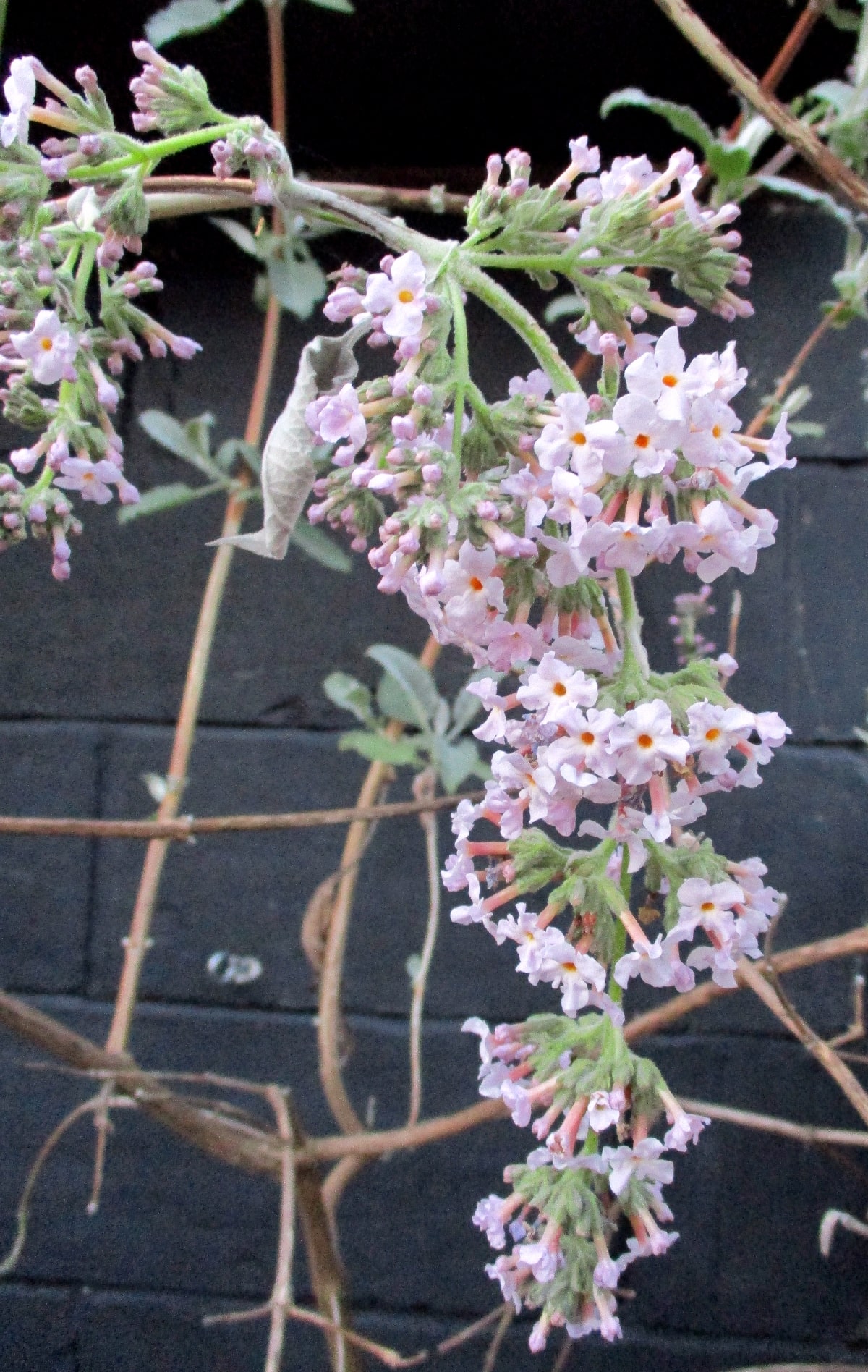
B. agathosma inflorescence.
Open full size image in a new window
Close-up of the flowers.
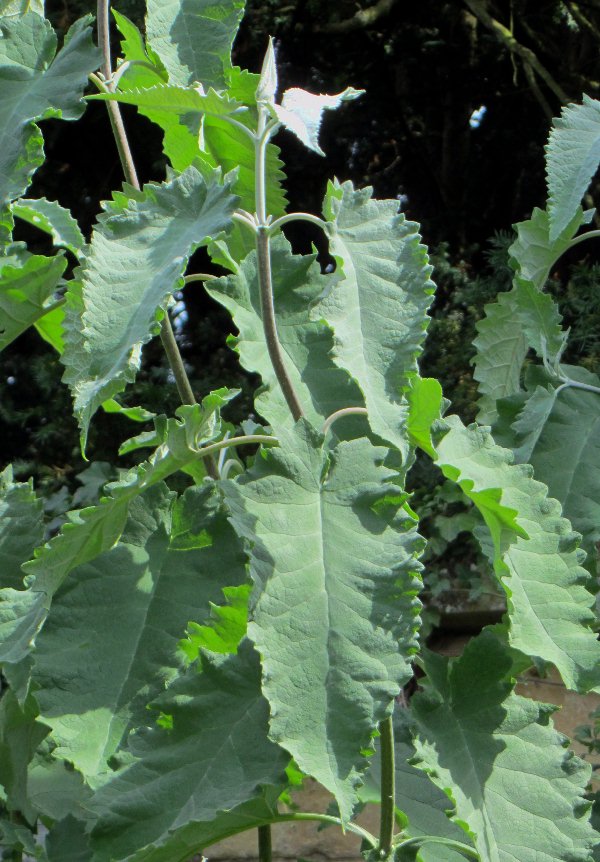
The large leaves are distinctive. On some stems the stipules are virtually absent.
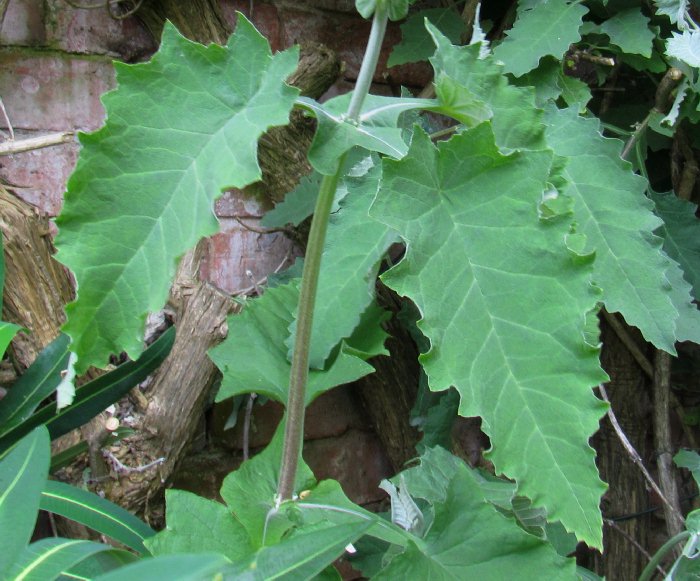
Whereas some stems have connate leaves.
Buddleja crispa
Type: farreri
The type previously known as Buddleja farreri resembles type: agathosma, and is a similar large shrub or small tree producing large sprays of lilac flowers in the spring. Both are best grown against a warm south-facing wall wall. The leaves are smaller with shorter petioles, so are not at all pendulous. Similarly, the corolla is somewhat smaller in diameter, although otherwise all flower parts are broadly the same.
It's possible these two types have become confused in the past and their close similarity suggests they are indeed variations of the same species.
Type: farreri is notable for its very high self-fertility, forming copious seed even in the absence of a compatible pollinator.
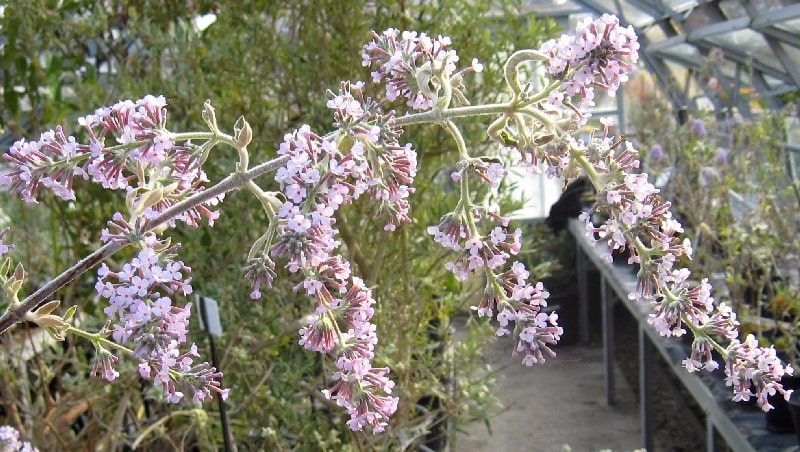
A typical type: farreri inflorescence.
(Photo by Andrew Brookes)
Buddleja crispa
Type: sterniana
Type: sterniana has features in common with the two types above such as toothed, felted foliage. It still forms a fairly large shrub, but the flowers and leaves are on a much smaller scale. Deciduous in all but the mildest locations, the flowers open just as the leaves begin to sprout again, late March to April in the UK. It's hardy, but the flower buds form in the autumn and are exposed over the winter, so they can be lost to cold winds. Sometimes the flowers start to open in the autumn if the weather is particularly mild, although they will be destroyed by the first frost.
The original plants were from seeds brought to Edinburgh by George Forrest, although by the end of the Second World War only a single specimen survived in the chalk garden of Colonel Stern, for whom the plant is named. The origin is uncertain, but most likely it's from Yunnan province, China (Cotton 1947).
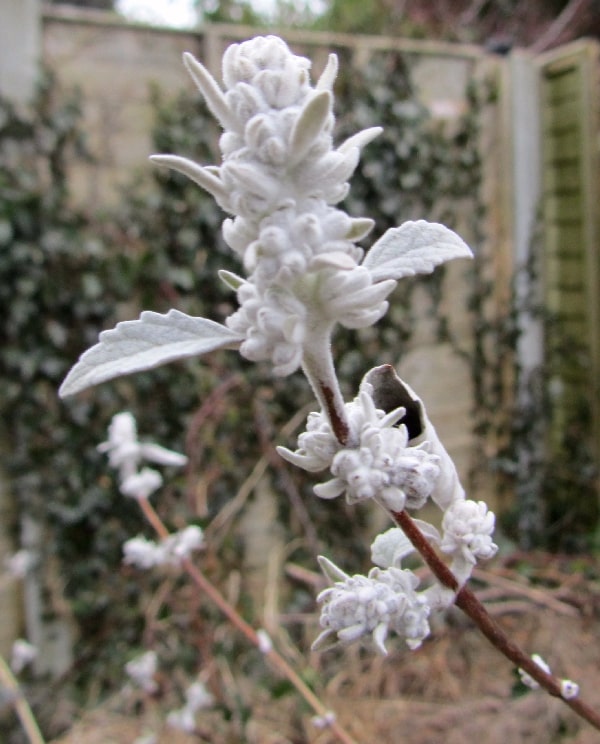
Left: the flower buds have to over-winter and can become dessicated.
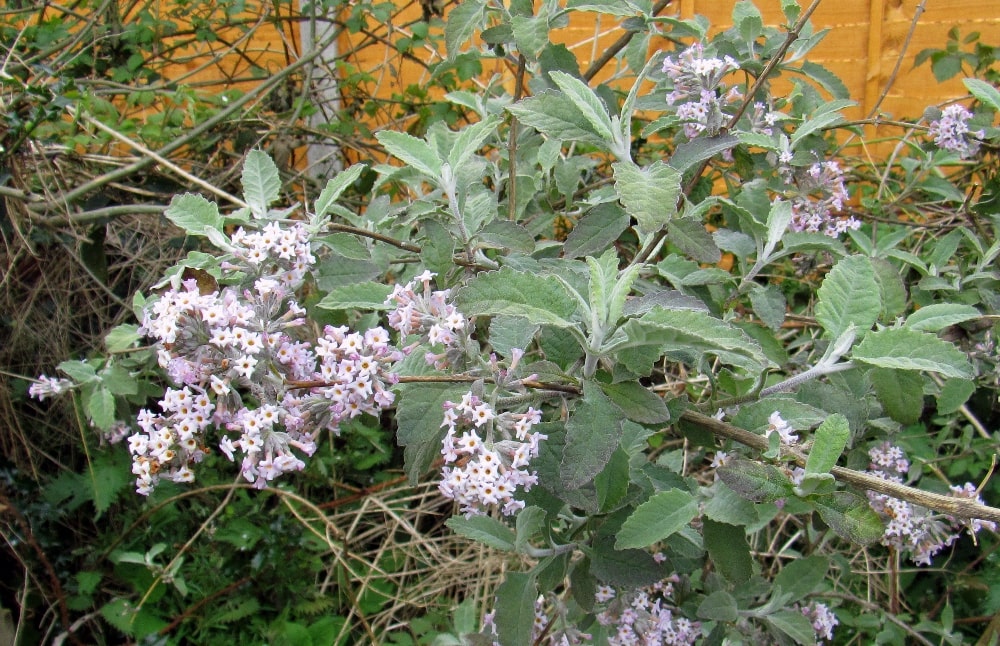
The sterniana foliage is smaller compared to the other types.
Buddleja crispa
Type: tibetica
Buddleja tibetica, as this type is commonly labelled, is not as widely grown as the other spring-flowering B. crispa types as it is more demanding about conditions. The species has evolved to be more xerophytic as it comes from dry valleys on the Tibet plateau and the persistent tomentum is more dense to cope with the dessicating winds, giving the leaves a grey to white appearance. Originally discovered at an altitude of 3,300 metres in the Llalang Valley, it doesn't take to the relatively warm and damp winters of the UK climate.
The flower buds appear before the foliage in the spring, and they open a dark-lilac gradually fading to very pale pink, almost white. This is the earliest flowering of all the B. crispa types (Cotton 1947).
Buddleja tibetica has also been known by the synonym Buddleja hastata.

Buddleja tibetica inflorescence.
Open full size image in a new window
(Photo by Andrew Brookes)
Hybrids of B. crispa
Leeuwenberg (1979) considered Buddleja x wardii, a naturally occuring hybrid 'species', to be a perfect intermediate between B. alternifolia and B. crispa. The leaves can be both alternate and opposite. No authentic living specimen is known to be held in any of the collections.
The plant sold commercially in the UK as B. caryopteridifolia appears to be a hybrid of B. alternifolia x B. crispa; the leaves of this plant are both oppposite and alternate. The foliage has the same distinctive scent as B. alternifolia, and is less felted than B. crispa. It forms a straggly, highly branched shrub and is fully deciduous. The flowers are intermediate between the putative parent species and it can flower both in early summer (May-June) and again in the autumn (September-October). Whether this is a native example of B. x wardii or another similar hybrid bred ex situ is uncertain, and I can only tentatively identify it as B. x wardii.
Other similar hybrids have been bred ex situ. Buddleja x pikei was raised by A.V. Pike at Hever Castle, Kent and is the cross B. alternifolia and one of the B. crispa types, alledgedly B. caryopteridifolia although this cannot be confirmed and it seems unlikely an authentic specimen of that species was available at that time. The best of the seedlings was named B. pikei 'Hever'.
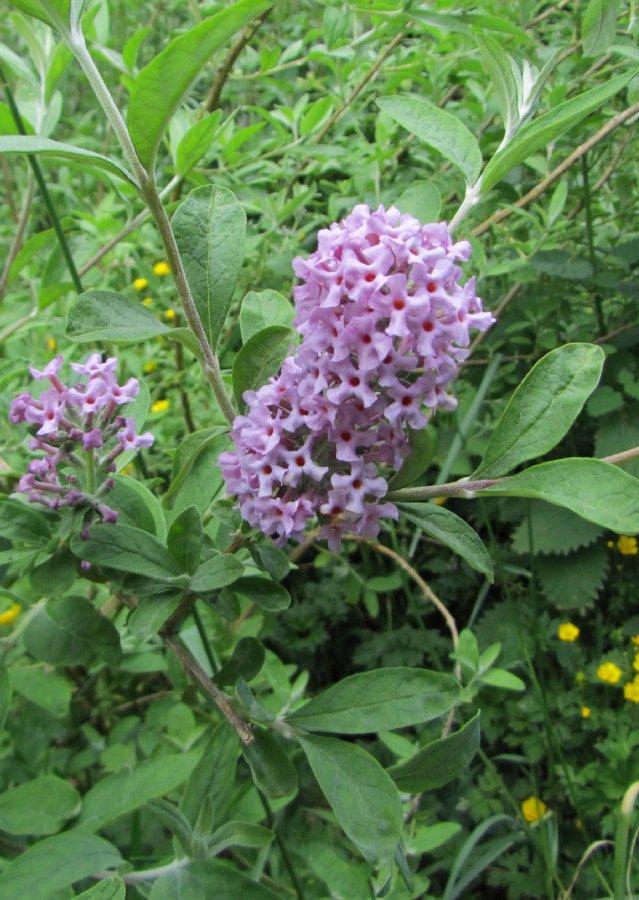
This plant, sold as B. caryopteridifolia, is a hybrid of B. alternifolia and B. crispa; its origin is unknown.
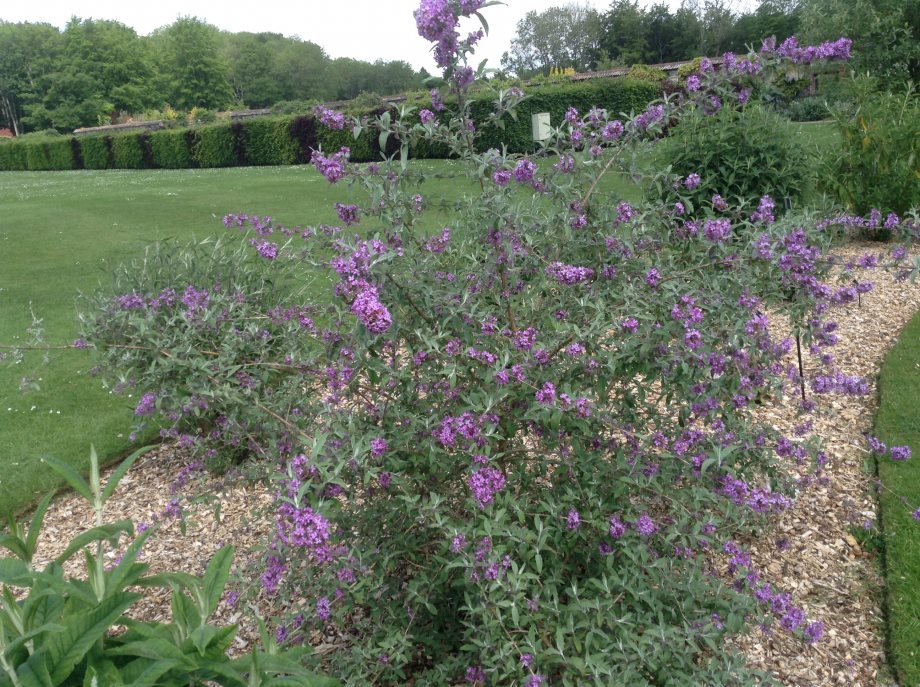
Longstock Gem is a late spring flowering hybrid of Type: agathosma x B. alternifolia. (Photo by Peter Moore.)
Peter Moore at the Longstock Park Nursery has bred a number of similar hybrids: 'Autumn Surprise' (B. crispa x B. alternifolia 'Argentea') flowers in the autumn; 'Longstock Silver' (B. crispa type: agathosma x B. alternifolia), a plant shy to flower and grown primarily for its very silver foliage; and 'Longstock Gem' (B. crispa type: agathosma x B. alternifolia) flowers in May just before B. alternifolia.
A close look at the flowers of 'Longstock Gem' shows a close similarity with those of the putative B. x wardii above.

A hybrid of B. crispa and B. alternifolia from The Lavender Garden.
A hybrid of B. alternifolia 'Argentea' with B. crispa (most likely type: farreri) recently arose in The Lavender Garden collection, although it has sadly since died. It was similar to the tentatively identified B. x wardii above except it had softer, grey foliage. The foliage was alternate, opposite or slightly offset. Shy to bloom, when they did emerge the flowers were intermediate between the species and in a panicle more like B. crispa. The flowering time, in common with several of the other hybrids mentioned, was late summer rather than the spring.
Two hybrids of B. crispa and B. lindleyana, very similar to each other, are 'Longstock Pride' and 'Pride of Hever'. The B. crispa genes are not very evident as the foliage is much the same as B. lindleyana and the flowers are arranged in B. davidii-like conical panicles that resemble neither parent, although they are a simillar purple shade to B. lindleyana. Another B. crispa hybrid worth noting is 'Bel Argent', a French hybrid arising from a cross with B.davidii.
'Salmon Spheres' is a very attractive hybrid made with the South American B. globosa. It grows quite large and flowers both spring and autumn. The flowers are arranged in loose spheres and a variable in colour, from salmon pink to orange. The foliage is grey and heavily felted
'Silver Anniversary' (syn. 'Morning Mist') is a cross of B. crispa with the South African B. loricata made by Peter Moore. A garden shrub that remains small and flowers intermittently from late spring into autumn. The flowers are similar to those of B. loricata and have a fine scent. However, the main feature is the soft, silvery foliage inherited from B. crispa. The spring-flowering B. crispa types: farreri and agathosma will also readily pollinate the African species B. salviifolia, although the resulting hybrids are of little horticultural merit.

Buddleja x 'Silver Anniversary' syn: 'Morning Mist'.
Synonymous species according to Leeuwenberg (1979)
Buddleja acosma Marquand
Buddleja agathosma Diels
Buddleja agathosma var. glandulifera Marquand
Buddleja caryopteridifolia W. W. Sm.
Buddleja caryopteridifolia var. eremophila (W. W. Sm.) Marquand
Buddleja caryopteridifolia var. lanuginosa Marquand
Buddleja crispa var. amplexicaulis Z.Y. Zhang
Buddleja crispa var. dicipiens Schmidt
Buddleja crispa var. farreri (Balf. f. et W. W. Sm.) Hand. - Mazz.
Buddleja crispa var. grandiflora (C. Marquand) S.Y. Pao
Buddleja eremophila W. W. Sm.
Buddleja farreri Balf. f. et W. W. Sm.
Buddleja hastata Prain ex Marquand
Buddleja incompta W. W. Sm.
Buddleja praecox Lingelsh.
Buddleja sterniana A. D. Cotton
Buddleja tibetica W. W. Sm.
Buddleja tibetica var. farreri (Balf. f. et W. W. Sm.) Marquand
Buddleja tibetica var. glandulifera Marquand
Buddleja tibetica var. grandiflora Marquand
Buddleja tibetica var. truncatifolia (Lévl.) Marquand
Buddleja truncata Gagnep.
Buddleja truncatifolia Lévl.
Buddleja whitei Kraenzlin.
References
Cotton, A. D. (1947). Spring Flowering Buddleias. RHS Journal Vol. 72. 1947. pp 427-437. Royal Horticultural Society, London.
Selected pages from Leeuwenberg, A.J.M. (1979) The Loganiaceae of Africa XVIII Buddleja L. II, Revision of the African & Asiatic species. H. Veenman & Zonen B. V., Wageningen, Netherlands.
Li, P. T. & Leeuwenberg, A. J. M. (1996). Loganiaceae, in Wu, Z. & Raven, P. (eds) Flora of China, Vol. 15. Science Press, Beijing, and Missouri Botanical Garden Press, St. Louis, USA
C.V.B. Marquand (1930) Revision of the Old World Species of Buddleja. Bulletin of Miscellaneous Information No.5 pp177-208. Royal Botanic Gardens, Kew.
X. Zhang, G. Chen, W. Gong, & Weibang Sun (2014) Buddleja caryopteridifolia (Scrophulariaceae), a species to be recognized based on morphology, floral scent, and AFLP data. Phytotaxa 161: 181-193.
Email:
buddlejagarden@gmail.com
© The Buddleja Garden 2011-2024.
